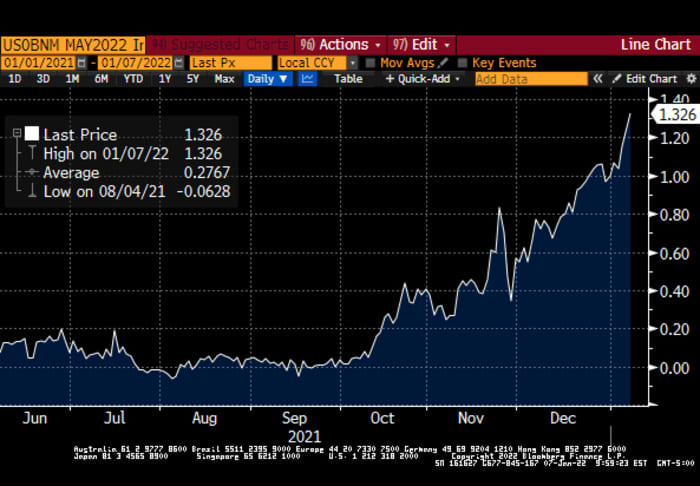Rates traders are continuing to price in the prospects of an aggressive start to the Federal Reserve’s next rate-hike cycle in coming months, despite Friday’s release of a disappointing 199,000 jobs gain for December.
After the jobs report was released, futures reflected a 71% chance of a 25 basis point hike in March and 29% likelihood the fed funds target rate will be 50 basis points higher than it is now by the Fed’s May meeting, according to CME’s FedWatch tool. That’s not too far from where both odds stood on Thursday. Such moves would lift the fed funds rate target to between 0.25% and 0.5% in March, and to 0.5% to 0.75% in May, from zero to 0.25% currently.
Also on Friday, overnight indexed swaps were reflecting the likelihood that Fed officials deliver something more than just a single 25 basis point hike by the end of their May meeting, according to Ben Emons, managing director of global macro strategy at Medley Global Advisors in New York.

Source: Bloomberg LP
The market is attempting to absorb the notion of what Emons is calling a “dual” tightening by the Fed, after the central bank’s December minutes revealed on Wednesday that nearly all policy makers were interested in reducing the Fed’s more than $ 8 trillion balance sheet at some point, in conjunction with hiking rates. Friday’s jobs report contained enough encouraging ingredients — such as a declining unemployment rate, higher average hourly earnings and job gains in previously hard-hit sectors like leisure — to “intensify expectations for a sooner and faster tightening of Fed policy” earlier in the day, the strategist said.
Read: The U.S. jobs report is not as weak as looks for the second month in a row. Here’s why.
“The headline jobs number was a bit misleading, and there are a lot of elements in the report to suggest that the U.S. may be approaching maximum employment,” Emons said via phone. “The market is trying to work out this possibility of a double or dual tightening, and doesn’t know what the impact of a smaller balance sheet will be, so it’s extrapolating that into fed funds futures.”
“The market is pricing in a campaign of sooner and faster tightening,” he said.
Expectations for a more aggressive hiking-campaign are also being projected in real yields, which continued to rise from steeply negative levels on Friday. Interestingly, though, such expectations are still not fully reflected in nominal Treasury yields, despite recent substantial gains.
Read: ‘Frankly, I’m surprised by how little yields moved’ since Fed minutes, with the jobs report looming
By late Friday afternoon, Treasury yields had posted their biggest one-week advance in years, helped by further advances in most rates on the day. The 10-year yield TMUBMUSD02Y, 0.866% advanced by 27.3 basis points this week, to 1.77%, for the biggest weekly gain since the period that ended Sept. 13, 2019, according to Dow Jones Market Data.
Sign up for our Market Watch Newsletters here.
On Friday, San Francisco Fed President Mary Daly said that the central bank could start to shrink its balance sheet after one or two rate hikes. Her remarks came a day after her colleague in St. Louis, James Bullard, said the first rate increase could come as soon as March. Bullard is a 2022 voter on the rate-setting Federal Open Market Committee.
“Today’s employment report, while kind of mixed, net-net is going to provide further support for the Federal Reserve’s hawkish pivot that investors are adjusting to this week,” said Leo Grohowski, chief investment officer at BNY Mellon Wealth Management in New York, which oversaw $ 307 billion as of September.
“The risk is that the Fed implements too much tightening, in a year in which we expect economic growth to slow naturally, and that the Fed’s pivot exacerbates what would already be a slowdown in the second half of this year,” Grohowski said via phone. “That’s not our central forecast, but is something the market has been thinking about.”
